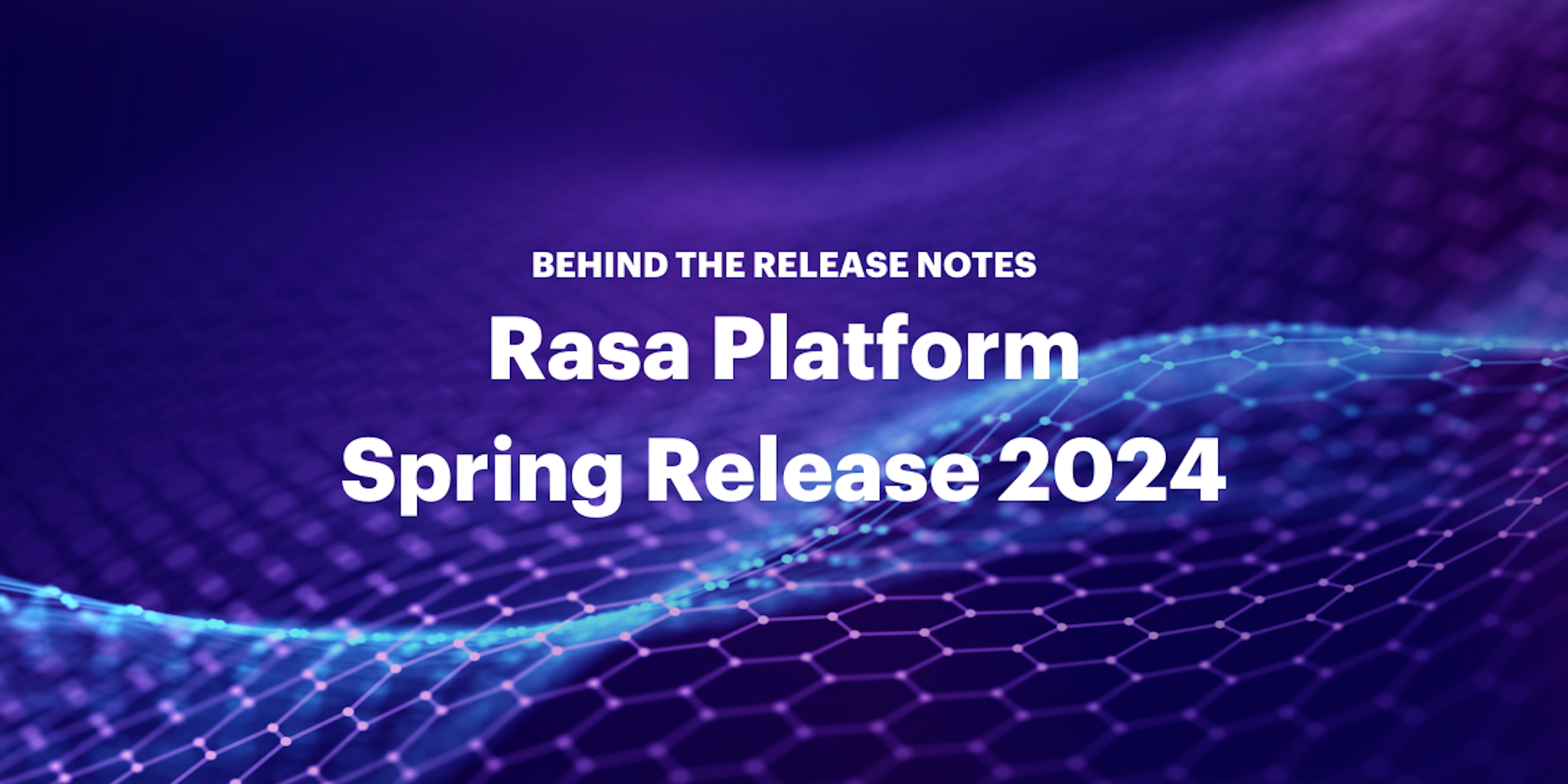April 18th, 2024
Behind the Release Notes: Rasa Platform Spring Release 2024
Lauren Goerz
Welcome to the latest enhancements in the Rasa Platform. The latest version introduces features that help you scale your Rasa assistants and provide a collaborative workflow to track, analyze, and improve the user journey. Read on to learn more about what is new in our user interface, Rasa Studio, and our conversational AI framework, Rasa Pro.
New in Rasa Studio 1.1 and 1.2:
Conversation Review
Conversation-driven development (CDD) centered workflows are essential to the success of conversational AI teams. We recommend regularly analyzing user conversations as a standard part of your team’s workflow. Attention to the user experience will help your team identify problems, highlight successes, and determine the best methods for future improvements.
Rasa Studio’s conversation review section supports this by providing direct access to the production chat transcripts, which you can sort by a growing set of conversation filters (conversation ID, date/time range, flow name, predicted intent, etc.). Analysts, designers, testers, and builders alike can use these filters to narrow down the types of conversations they want to view for a more targeted approach to analysis.
Some best practices to get you started with the Review panel:
- Perform a general review of user conversations to get a sense of the user experience and identify opportunities for continuous improvement. In the conversation review panel, select a time range or channel and read through a sample of conversations to spot-check the user experience. Mark them as reviewed to ensure more coverage across the project, and assign a tag to any noteworthy conversations for further review later.
- Perform an investigative review to diagnose performance changes. Users are dynamic; therefore, AI assistant performance metrics will rise and fall throughout the development lifecycle. To understand the root cause, filters can isolate a set of conversation data for further investigation.
- For example, suppose you notice a decrease in your “Update_Address” flow performance. In that case, you can use the Review Panel filters to separate a set of conversations based on Date/Time, and Flow Name (Update_Address) to analyze a set of conversations that entered the “Update_Address” flow. Reading these user conversations will help you define whether the drop in performance is related to a design issue, lack of scope, technical problem, or even something entirely external to the AI Assistant.
- Perform a post-launch review of new user journeys. Once a new journey is live, use the conversation review panel to filter by channel and flow(s) to see the first few conversations trickle in and read through to ensure the user journey runs smoothly. Highlight successful conversation IDs to share with your colleagues to demonstrate the exceptional impact of their hard work.
Additional Rasa Studio improvements:
- Set Slots: Maximize your AI assistant's contextual memory with Rasa Studio’s newest node type, “Set Slots.” This feature lets you manually set and clear existing slot values, allowing you to build more detailed dialogue conditions for advanced scenarios.
- Logical Operator Extension: Ensure maximum control over slot values with an extended list of logical operators for nuanced handling of contextual information.
- NLU Triggers: Typically, the command generator activates flows to progress the dialogue in a CALM-only AI assistant. However, now in Studio and Pro, you can activate Flows using either a description or your existing intents.
- Check out the Change Log for more information and updates.
New in Rasa Pro 3.8
- CALM Migration Pathway: Over the last few months, we’ve rolled out the next generation of our dialogue framework: CALM - Conversational AI with Language Models. A key benefit of CALM is leveraging language models to better understand your users in context without any intent or maintenance of NLU models. Nonetheless, we know that migration to a new paradigm takes time and needs to happen iteratively. This release features a strategic migration path that enables a single AI assistant with a CALM approach and an NLU-based system to coexist in parallel. This means you can now run a CALM assistant alongside a legacy Rasa assistant that uses intents and stories.
- Embedding Flows: Enhancing flow reusability is paramount to streamline development workflows. Developers can now embed flows via the
callstep to maximize efficiency by reusing components across the project, saving time and effort in the development process.
Additional Rasa Pro Improvements:
- Reduced Costs at Scale: We’re always looking for ways to make Rasa as cost-effective as possible in your environment. By asking the system to only seek semantically relevant flows following each user query, you reduce the costs considerably by limiting the number of tokens in each prompt as you scale to many flows.
- Enterprise Search Guardrails for Enhanced Security: The upgraded version reduces the risk of hallucination by introducing Domain Guardrails to prevent answering out-of-domain questions. Additionally, source awareness enhances the system by providing references for answers from public knowledge sources, which increases confidence in response accuracy and reduces risk through transparent and reliable answer generation
- Tracing Improvements for Increased Transparency: Monitoring your system’s cost and performance is crucial for optimizing latency and resource utilization. We’ve extended our open telemetry-based tracing system to include enhanced tracing functionality that enables effective debugging, monitoring of cost and latency, and optimization of the different CALM components by tracking the execution of requests as they flow through the system.
Check out the change log for more information and updates.
Want to learn how the Rasa platform can help you redefine your interactions with customers and enhance their experiences? Talk with Sales.
